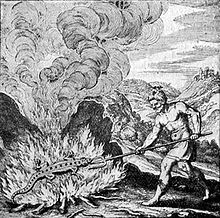The “Flames and Phantoms: Unraveling the Intricate Bond between Fire and the Salamander

Spark your curiosity and dive into a world where fire intertwines with the enigmatic salamander. In this article, we embark on a mesmerizing journey through the smoldering realms of ancient connections, mythical legends, and natural wonders. Brace yourself for a fiery adventure as we unearth the fascinating fire adaptations of these intriguing creatures. From outdoor blazers to pyromaniacs’ nightmares, the salamander’s mystical bond with flames will leave you in awe. Delve deep into the realms of cultural depictions and uncover the intricate tapestry of fire goddesses and mythical creatures entwined with these elusive beings. But hold on, there’s more! Prepare to be captivated by the mystical charm surrounding salamanders’ fire-starting abilities as we delve into the perplexing world of spontaneous combustion and magical allure. Amidst the awe, we confront the grim reality of extinction threats, as climate change poses a perilous challenge to the fire-dependent habitats of these remarkable beings. Fear not, for we shall also explore the bright side, where the luminescent secretions of their skin inspire revolutionary flame-retardant technologies. Marvel at the unsung heroes, the firefighters of the forest, as salamanders play a vital role in maintaining their ecosystems and shaping fire ecology. Our journey concludes by tracing the emergence of these fire-adapted creatures, deepening our understanding of evolution’s eternal dance and the key factors that drive their survival. So, ignite your curiosity and join us as we unravel the extraordinary bond between fire and salamander, where mystery, wonder, and scientific marvel await.
The Fiery Connection: Exploring the Ancient Relationship between Fire and the Salamander
Examining Ancient Beliefs and Legends Surrounding Salamanders’ Association with Fire
Ancient civilizations have long been fascinated by the magical and mysterious connection between salamanders and fire. In various mythologies and legends, salamanders are often portrayed as creatures that are either born from or closely associated with fire. For example, in ancient Egyptian mythology, salamanders were believed to be created from the fire produced by the sun god Ra. These beliefs extend beyond Egypt, as many cultures across the globe have similar stories and beliefs about salamanders and their connection to fire.
One of the most well-known ancient beliefs is that salamanders are able to withstand fire and even live within it. This belief is rooted in the observation that salamanders are often found in areas prone to wildfires. In ancient Greece, it was believed that salamanders possessed the ability to extinguish fires. This belief may have stemmed from the observation that salamanders would often emerge from logs that were burning. These ancient beliefs and legends reflect the deep-rooted connection between salamanders and fire in human culture.
Scientific Research on Salamanders’ Adaptations to Fire and Heat
Scientific research has shed light on the fascinating adaptations of salamanders to fire and heat. Salamanders have unique physiological traits that enable them to survive and thrive in fire-prone environments. One such adaptation is their ability to regenerate lost body parts, including limbs and even parts of their hearts and brains. This regenerative capacity allows salamanders to withstand injuries caused by fires and quickly recover.
Furthermore, salamanders have highly permeable skin, which helps them effectively exchange gases and maintain their body temperature. Their skin also secretes mucus that provides protection against heat and prevents dehydration in high-temperature environments. Additionally, some species of salamanders have evolved heat-resistant proteins that aid in their survival during fires.
Scientific research has also revealed that salamanders are attracted to heat and will actively seek out warm environments. They possess thermosensors that enable them to detect heat sources and navigate towards them. This behavior suggests that salamanders not only have the ability to survive in fire-affected areas but also possess some level of affinity towards fire.
From Outdoor Blazers to Pyromaniacs’ Nightmares: The Salamanders’ Fascinating Fire Adaptations
The Remarkable Ability of Salamanders to Survive and Thrive in Fire-Prone Environments
In fire-prone environments, salamanders have developed remarkable adaptations that allow them to not only survive but also thrive. One such adaptation is their ability to find refuge in underground burrows or water bodies during wildfires. These safe havens protect salamanders from the direct heat and flames, ensuring their survival.

Additionally, salamanders have the ability to remain inactive for extended periods when faced with unfavorable conditions. They can enter a state of dormancy, known as aestivation, to conserve energy and survive harsh environments. During fires, salamanders may seek shelter in cool, damp areas within logs or rocks until the danger has passed.
Furthermore, salamanders have a diet that consists largely of insects and other small invertebrates. In fire-affected areas, these food sources become abundantly available as they are attracted to the regrowth and decaying organic matter after a fire. This adaptability in food sources allows salamanders to take advantage of the post-fire environment and thrive in fire-prone habitats.
Understanding the Physiology and Traits that Enable Salamanders to Withstand High Temperatures
The physiology and traits of salamanders play a crucial role in their ability to withstand high temperatures. Salamanders have a strong resistance to heat due to their efficient cardiovascular system and specialized blood vessels. These blood vessels help distribute heat evenly throughout their bodies, preventing thermal damage to vital organs.
Moreover, salamanders possess a remarkable ability to regulate their body temperature. They can lower their metabolic rate and reduce oxygen consumption during periods of heat stress. This physiological adaptation allows them to conserve energy and survive in high-temperature environments.

Another important trait of salamanders is their ability to retain moisture. Their skin is highly permeable and can absorb and retain water for extended periods. This adaptation helps them minimize water loss in fire-prone habitats and maintain hydration during and after fires.
Fire Goddesses and Mythical Creatures: Uncovering Cultural Depictions of Salamanders in Relation to Fire
Exploring Salamanders’ Symbolism and Representation in Ancient Mythology and Folklore
Salamanders have been depicted in various ancient mythologies and folklore as powerful and mystical creatures associated with fire. In European folklore, salamanders were believed to be guardians of fire. They were considered as magical beings that could control fire and bring warmth to the hearth. Salamanders were often associated with the element of fire itself and were believed to possess the power to purify and ward off evil spirits.
Moreover, salamanders have been associated with alchemy, an ancient practice that aimed to transform elements and create potions of great power. In alchemical symbolism, the salamander represented the transformative power of fire. It was believed that the salamander could withstand the intense heat of the alchemical furnace and emerge unscathed, symbolizing the purification and transformation of materials.
Unraveling the Cultural Significance and Interpretations of Salamanders as Fire-associated Beings
The cultural significance of salamanders as fire-associated beings is rooted in their remarkable adaptations to fire and heat. The ability of salamanders to survive and even thrive in fire-affected habitats captured the imagination of ancient societies. Their resilience to fire became a symbol of strength, endurance, and transcendence.
In addition, the association of salamanders with fire in mythology and folklore may have served as a metaphor for the transformative power of adversity. Just as fire can destroy and purify, salamanders were seen as beings capable of withstanding and transcending the challenges and hardships of life.
The interpretations of salamanders’ fire-associated traits vary across different cultures and time periods. Some viewed salamanders as benevolent beings that brought warmth and protection, while others portrayed them as destructive and dangerous entities associated with natural disasters. These diverse interpretations reflect the complex and multifaceted nature of the relationship between salamanders and fire.
Spontaneous Combustion or Magical Charm? The Mystery of Salamanders and Fire-Starting Abilities
Investigating Salamanders’ Potential Involvement in Natural Fires and Ignition Phenomena
One of the intriguing aspects of the relationship between salamanders and fire is the potential role of salamanders in natural fires and ignition phenomena. While there have been anecdotal accounts of salamanders causing fires, scientific evidence supporting this claim is scarce. However, some researchers hypothesize that the behavior of salamanders, such as their attraction to heat sources, could potentially lead to accidental ignition in certain scenarios.
In fire-prone environments, it is possible for a salamander to accidentally ignite vegetation or other flammable materials by coming into contact with embers or creating sparks. However, it is important to note that salamanders are not intentionally fire-starters or pyromaniacs. They are simply organisms adapted to survive and thrive in fire-affected habitats.
Examining the Role of Salamanders in Historical Accounts of Fire-Causing Events and Folklore
Historical accounts and folklore often mention salamanders in relation to fire-causing events. However, these accounts are often based on misconceptions or exaggerated tales. In some cases, salamanders may have been mistakenly blamed for fires that were the result of other causes.
Folklore and superstitions may have further perpetuated the idea of salamanders as fire-starters. Stories and legends surrounding mysterious fires could have been attributed to these intriguing creatures. However, it is important to approach historical accounts with a critical lens and consider other possible explanations for fire-causing events.

To fully understand the role of salamanders in fire-causing phenomena, further scientific research is needed to investigate the potential interactions between salamanders and fire in different environments.
Extinction Threats
Climate Change and Its Impact on Salamanders’ Fire-Dependent Habitats
Climate change poses a significant threat to the habitats of fire-dependent salamanders. These unique amphibians have evolved to thrive in areas that experience periodic fires, which play a crucial role in maintaining the health and diversity of the ecosystem. However, as the planet’s climate continues to warm, the frequency and intensity of wildfires are increasing, putting salamanders at risk.

With rising temperatures, the occurrence of droughts becomes more common, leaving the forests and grasslands where salamanders reside dry and more susceptible to igniting. This leads to more frequent, intense wildfires that destroy the salamanders’ habitats. The loss of vegetation and shelter in these fires results in a lack of suitable breeding and foraging sites, further exacerbating the threat to salamander populations.
Furthermore, climate change also affects the habitat suitability for salamanders by altering the temperature and moisture conditions necessary for their survival. These changes can force salamanders to seek new areas outside their traditional range, where they may face competition from other species or encounter unfamiliar predators. This disruption to their natural habitat can have a detrimental impact on their population size and genetic diversity, increasing their vulnerability to extinction.
Incendiary Alchemy
How Salamander Skin Secretions Inspire Flame-Retardant Technologies
Salamanders possess a remarkable defense mechanism against fire – their skin secretions. These secretions contain unique chemicals that have caught the attention of scientists in the field of flame-retardant technologies. By studying these chemicals, researchers are exploring new ways to develop more effective and environmentally friendly flame-retardant materials.
The secretions of salamanders contain compounds that can withstand high temperatures without igniting, making them excellent fire-resistant materials. These compounds work by interrupting the chemical reactions that occur during combustion, effectively slowing down or preventing the spread of flames. This ability to resist fire has inspired the development of flame-retardant coatings for various applications, such as electronics, textiles, and building materials.
By harnessing the properties of salamander skin secretions, scientists aim to create flame-retardant materials that are not only more efficient but also safer for the environment. Traditional flame-retardant chemicals often contain harmful substances that can pose health risks and have negative ecological impacts. The natural compounds found in salamander secretions offer a promising alternative, potentially reducing the reliance on potentially harmful chemicals and promoting sustainable fire safety solutions.
Firefighters of the Forest
The Vital Role of Salamanders in Ecosystem Maintenance and Fire Ecology
Salamanders play a crucial role in forest ecosystems as “firefighters” due to their unique adaptations and behaviors. These amphibians actively participate in fire ecology by influencing various aspects of the ecosystem’s post-fire recovery and maintaining overall ecological balance.
After a fire, salamanders, particularly species like the spotted salamander and the long-toed salamander, emerge from their underground burrows to take advantage of the new habitat conditions. They thrive in the freshly burned areas, utilizing the abundant food resources resulting from the fire. As they forage on insects and other small invertebrates, salamanders help control population levels and prevent outbreaks of potential pests.
Moreover, salamanders also play a vital role in nutrient cycling within the ecosystem. Their feeding activity and subsequent excretion contribute to the redistribution of essential nutrients, such as nitrogen and phosphorus, back into the soil. This process enhances soil fertility and promotes the growth of vegetation, aiding in the regeneration of the forest.
In addition, salamanders serve as prey for various species, including birds, reptiles, and mammals. Their presence in the food chain provides sustenance for higher trophic levels and ensures a healthy predator-prey balance within the ecosystem.
Evolution’s Eternal Dance
Tracing the Emergence of Fire-Adapted Salamanders
The Key Factors Driving Their Survival
The emergence of fire-adapted salamanders can be traced back to the intricate dance of evolution and the key factors that have driven their survival over time. Extensive research has shed light on the mechanisms by which salamanders have evolved to withstand and thrive in fire-prone environments.
One of the key factors driving their survival is their ability to retreat to underground burrows or seek refuge in moist areas during fires. This behavior allows them to escape the direct heat and flames, offering protection until the fire subsides. Salamanders have developed heat-resistant adaptations, such as thick skin and the ability to tolerate high temperatures, which enable them to survive in close proximity to fire.
Furthermore, their life cycles have also evolved in response to fire. Many fire-adapted salamanders lay their eggs in bodies of water, such as ponds or streams, which provide protection against fire. These aquatic habitats act as refuges where salamander larvae can develop and grow safely away from the immediate dangers of fire.
Natural selection has played a vital role in shaping the traits of fire-adapted salamanders. Individuals with genetic variations that confer better heat resistance, efficient escape behaviors, and reproductive strategies suited to fire-prone environments have a higher chance of survival and reproduction. Over time, these favorable traits become more prevalent in the population, enhancing their overall resilience to fire.
Overall, the emergence and survival of fire-adapted salamanders are the result of an intricate interplay between evolution and the unique ecological pressures imposed by fire. These adaptations highlight the incredible resilience of these amphibians and showcase nature’s diversity and ingenious solutions for thriving in challenging environments.
Unleashing the Blaze: The Enthralling Saga of Fire and the Salamander
Roaming across ancient myths, sizzling adaptations, and scorching habitats, this captivating journey into the fiery world of the salamander has illuminated the extraordinary bond between fire and these enigmatic creatures. From mesmerizing tales of fire goddesses to the spellbinding mystery surrounding their fire-starting capabilities, the influence of fire on salamanders is nothing short of intriguing. As climate change threatens their fire-dependent havens, these resilient amphibians face an uncertain future. Yet, through their innate flame-retardant skin secretions, they bestow upon us an awe-inspiring revelation – nature’s potential to ignite ingenious solutions to fire safety. Not mere pyromaniacs’ nightmares, salamanders embody the vital role of firefighters, diligently maintaining the delicate harmony of ecosystems and shaping the very landscape we tread upon. With each flicker and crackle, the evolution of these fire-adapted salamanders dances on, reminding us of the endless wonders awaiting discovery within the dazzling realm of fire and the salamander.
Frequently Asked Questions
1. What is the symbolic significance of fire and salamander in literature and mythology?
Fire and salamander have long been associated with transformation and rebirth in literature and mythology. The salamander, believed to be able to withstand fire, represents resilience and the ability to overcome challenges. Meanwhile, fire symbolizes passion, destruction, and renewal. Together, they often represent the journey of transformation and the power of resilience.
2. Are salamanders really able to withstand fire?
Contrary to popular belief, salamanders cannot withstand direct exposure to fire. The myth originated from ancient beliefs that salamanders could be found in burning logs due to their habitat preferences. However, salamanders are amphibians and are susceptible to extreme heat. It is important to understand that the association with fire is symbolic rather than literal in most contexts.
3. How is the fire and salamander concept depicted in Ray Bradbury’s “Fahrenheit 451”?
In “Fahrenheit 451,” Ray Bradbury uses the fire and salamander symbolically to illustrate the destructive power of censorship and the suppression of knowledge. The firemen’s role in this dystopian society is to burn books, symbolizing the eradication of ideas and free thought. The salamander represents their profession, as firefighters are called “firemen” in the book. The concept reflects the transformative power of words and the dangers of a society that fears knowledge.
4. What is the historical significance of fire and salamander symbolism?
The symbolism of fire and salamander has roots in ancient mythology and alchemy. In ancient Greece, salamanders were believed to be born from fire, associating them with the element’s transformative nature. In alchemical texts, the salamander represented the purification process of substances through fire. Over time, these symbols influenced art, literature, and philosophy, becoming synonymous with rebirth, passion, and the power to overcome challenges.
5. How can the fire and salamander symbolism be applied to personal growth and resilience?
The fire and salamander symbolism can inspire personal growth and resilience by encouraging us to embrace transformation and bounce back from adversity. It symbolizes the ability to rise from the ashes, harness passion, and overcome obstacles. By embodying the spirit of the salamander, we can find the strength to adapt, embrace change, and continuously reinvent ourselves on our journey towards personal growth and resilience.




